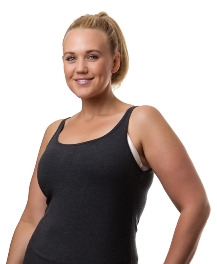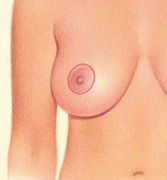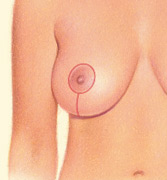Breast Procedures
What is a Breast Lift?

Also known as mastopexy, a breast lift raises the breasts by removing excess skin and tightening the surrounding tissue to reshape and support the new breast contour. Sometimes the areola becomes enlarged over time, and a breast lift will reduce this as well. A breast lift can rejuvenate your figure with a breast profile that is more youthful and uplifted.
A woman’s breasts often change over time, losing their youthful shape and firmness. These changes and loss of skin elasticity can result from:
- Pregnancy
- Breastfeeding
- Weight fluctuations
- Aging
- Gravity
- Heredity
Is it right for me?
Breast lift surgery is a highly individualized procedure and you should do it for yourself, not to fulfill someone else’s desires or to try to fit any sort of ideal image. A breast lift is a good option for you if:
- You are physically healthy and maintain a stable weight
- You do not smoke
- You are bothered by the feeling that your breasts sag or have lost shape and volume
- Your breasts have a flatter, elongated shape or are pendulous
- When unsupported, your nipples fall below the breast crease
- Your nipples and areolas point downward
- You have stretched skin and enlarged areolas
- One breast is lower than the other
Consultation and Preparing for Surgery
During your consultation be prepared to discuss:
- Your surgical goals
- Medical conditions, drug allergies, and medical treatments
- Current medications, vitamins, herbal supplements, alcohol, tobacco, and drug use
- Previous surgeries
- If you have a family history of breast cancer
- The results of any mammograms or previous biopsies
Your surgeon may also:
- Evaluate your general health status and any pre-existing health conditions or risk factors
- Examine your breasts and may take detailed measurements of their size and shape, skin quality, and placement of your nipples and areolas
- Take photographs
- Discuss your options
- Recommend a course of treatment
- Discuss likely outcomes of breast lift surgery and any risks or potential complications
- Discuss the use of anesthesia during your breast lift
Prior to surgery, you may be asked to:
- Get lab testing or a medical evaluation
- Take certain medications or adjust your current medications
- Get a baseline mammogram before surgery and another one after surgery to help detect any future changes in your breast tissue
- Stop smoking
- Avoid taking aspirin, anti-inflammatory drugs, and herbal supplements as they can increase bleeding
Breast lift surgery may be performed in an accredited office-based surgical center, outpatient or ambulatory surgical facility, or a hospital. Be sure to arrange for someone to drive you to and from surgery and to stay with you for at least the first night following surgery.
The Procedure
Your breast lift surgery can be achieved through a variety of incision patterns and techniques. The appropriate technique for you will be determined based on:
- Breast size and shape
- The size and position of your areolas
- The degree of breast sagging
- Skin quality and elasticity as well as the amount of extra skin
Step 1 – Anesthesia
Medications are administered for your comfort during the surgical procedure. The choices include intravenous sedation and general anesthesia. Your doctor will recommend the best choice for you.
Step 2 – The incision
There are three common incision patterns:
- Around the areola
.jpg)

- Around the areola and vertically down from the areola to the breast crease
.jpg)

- Around the areola, vertically down from the breast crease and horizontally along the breast crease


Step 3 – Reshaping your breasts
After your doctor makes the incisions:
- The underlying breast tissue is lifted and reshaped to improve breast contour and firmness.
- The nipple and areola are repositioned to a natural, more youthful height.
- If necessary, enlarged areolas are reduced by excising skin at the perimeter.
- Excess breast skin is removed to compensate for a loss of elasticity.
Step 4 – Closing the incisions
After your breasts are reshaped and excess skin is removed, the remaining skin is tightened as the incisions are closed. Some incision lines resulting from breast lift are concealed in the natural breast contours; however, others are visible on the breast surface. Incision lines are permanent, but in most cases will fade and significantly improve over time.Many women desire the smallest scar possible. However, your plastic surgeon will recommend the incisions which best suit your anatomy. Listen to your surgeon and do not diminish your result by demanding an incision that will not be appropriate for you.Sutures are layered deep within the breast tissue to create and support the newly shaped breasts. Sutures, skin adhesives and/or surgical tape may be used to close the skin.
Step 5 – See the results
The results of your breast lift surgery are immediately visible. Over time, post-surgical swelling will resolve and incision lines will fade. Satisfaction with your new image should continue to grow as you recover and realize the fulfillment of your goal for breasts which have been restored to a more youthful and uplifted position.
Risks and Safety
The decision to have breast lift surgery is extremely personal, and you’ll have to decide if the benefits will achieve your goals and if the risks and potential complications are acceptable. You will be asked to sign consent forms to ensure that you fully understand the procedure and any risks and potential complications.
The risks include:
- Anesthesia risks
- Bleeding or hematoma formation
- Infection
- Poor healing of incisions
- Changes in nipple or breast sensation, which may be temporary or permanent
- Breast contour and shape irregularities
- Breast asymmetry
- Fatty tissue found deep in the skin might die (fat necrosis)
- Fluid accumulation
- Potential partial or total loss of nipple and areola
- Deep vein thrombosis, cardiac and pulmonary complications
- Possibility of revisional surgery
These risks and others will be fully discussed prior to your consent. It is important that you address all of your questions directly with your plastic surgeon.
Some women may want to consider placement of a breast implant in addition to the breast lift. An implant can provide improved upper breast fullness or cleavage. Implants can be placed at the same time or as a second procedure, depending on the experience of the surgeon.
After your breast lift procedure is completed, dressings or bandages will be applied to the incisions. You’ll need to wear an elastic bandage or support bra to minimize swelling and support your breasts as they heal. A small, thin tube may be temporarily placed under the skin to drain any excess blood or fluid that may collect.
You will be given specific instructions that may include how to care for your breasts following surgery, medications to apply or take orally to aid healing and reduce the potential for infection, specific concerns to look for at the surgical site or in your general health, and when to follow up with your plastic surgeon.
Be sure to ask your plastic surgeon specific questions about what you can expect during your individual recovery period.
- Where will I be taken after my surgery is complete?
- What medication will I be given or prescribed after surgery?
- Will I have dressings/bandages after surgery?
- When will they be removed?
- Are stitches removed? When?
- When can I resume normal activity and exercise?
- When do I return for follow-up care?
Results

The results of your breast lift surgery are immediately visible. Over time, post-surgical swelling will resolve and incision lines will fade. Satisfaction with your new image should continue to grow as you recover from surgery. The final results of your breast lift will appear over the next few months as breast shape and position continue to settle. Incision lines are permanent but will continue to fade over time.
The results of your breast lift surgery will be longlasting. Over time, your breasts can continue to change due to aging and gravity. You’ll be able to retain your new look longer if you:
- Maintain your weight
- Keep a healthy lifestyle
Special note:
Breast surgery should be entertained after child bearing is completed. Changes that occur in the breasts during pregnancy can minimize or reverse the improvement a breast lift provides. Likewise, significant weight loss after breast surgery can negatively impact breast appearance.
Following your physician’s instructions is essential to the success of your surgery. It’s important that the surgical incisions are not subjected to excessive force, swelling, abrasion, or motion during the time of healing. Your doctor will give you specific instructions on how to care for yourself.
Cost
Prices for a breast lift can vary. A surgeon’s cost may be based on his or her experience, the type of procedure used, and the geographic location of the office. Many plastic surgeons offer patient financing plans, so be sure to ask.
Cost may include:
- •Anesthesia fees
- Hospital or surgical facility costs
- Medical tests
- Post-surgery garments
- Breast implant fees
- Prescriptions for medication
- Surgeon’s fee
Most health insurance plans will not cover breast lift surgery. You must carefully review your health insurance policy.
